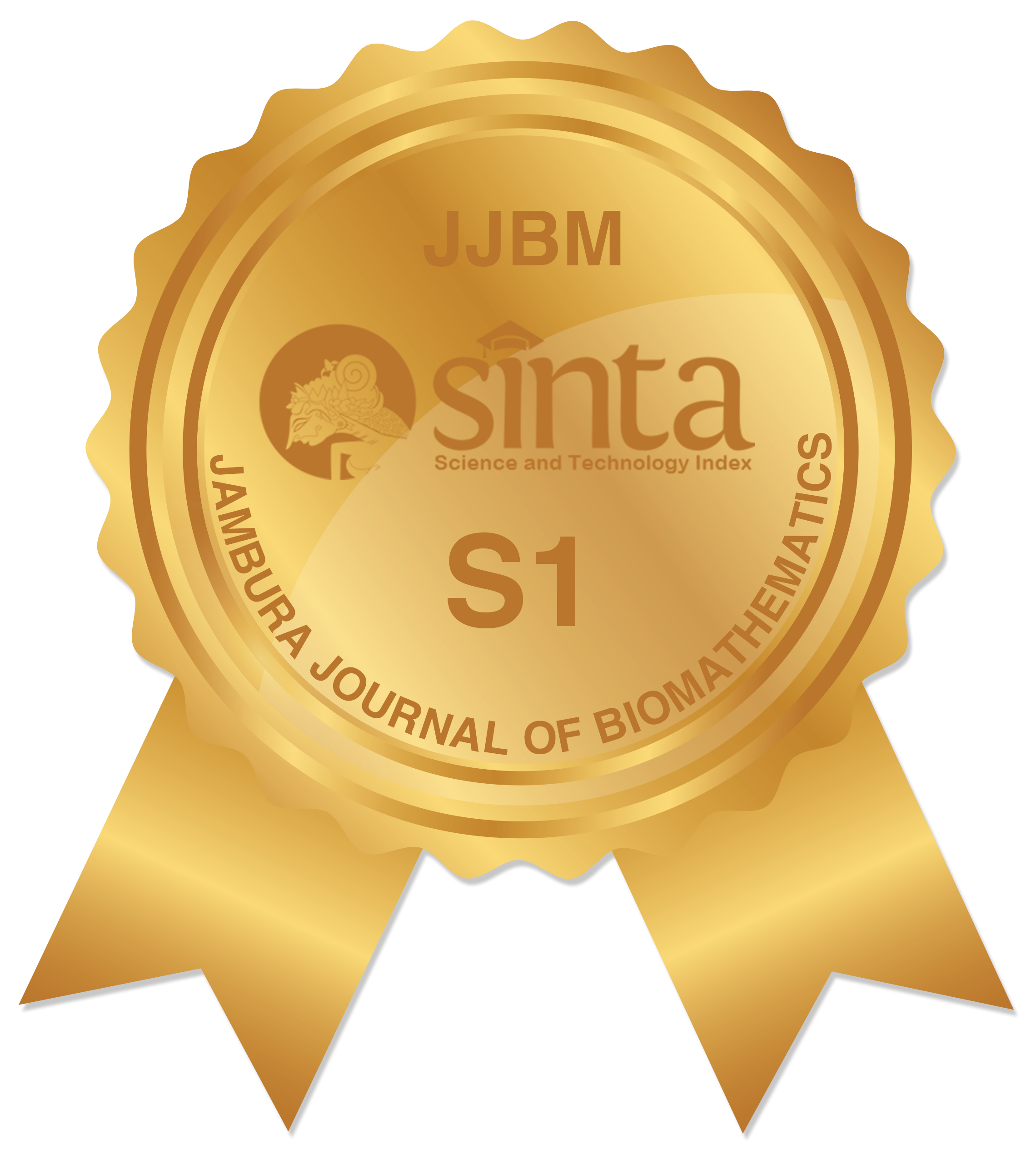Unveiling SIR Model Parameters: Empirical Parameter Approach for Explicit Estimation and Confidence Interval Construction
Abstract
We propose a simple parameter estimation method for the Susceptible-Infectious-Recovered (SIR) model. This method offers explicit estimates of parameters using second-order numerical derivatives to construct empirical parameters. In addition, the method constructs confidence intervals, providing a robust assessment of parameter uncertainty. To validate the accuracy of our method, we applied it to simulated data, in order to demonstrate its effectiveness in accurately estimating the true model parameters. Furthermore, we applied this method to actual COVID-19 case data from the USA, Indonesia, and the Philippines. This application enables the estimation of parameters and reproductive numbers, along with their confidence intervals, thus underscoring the efficacy of our technique. Notably, the parameter estimates obtained through our approach successfully predicted the case numbers in all three countries, confirming its predictive reliability. Our method offers significant advantages in terms of simplicity and accuracy, making it an invaluable tool for epidemiological modeling and public health planning.
Keywords
Full Text:
PDFReferences
W. O. Kermack and A. G. McKendrick, "A contribution to the mathematical theory of epidemics" Proceedings of the Royal Society of London. Series A, Containing Papers of a Mathematical and Physical Character, vol. 115, no. 772, pp. 700-721, 1927. DOI:10.1098/rspa.1927.0118
D. Tudor, "A deterministic model for herpes infections in human and animal populations" SIAM Review, vol. 32, no. 1, pp. 136-139, 1990. DOI:10.1137/1032003
B. J. Coburn, B. G. Wagner, and S. Blower, "Modeling influenza epidemics and pandemics: insights into the future of swine flu (h1n1)" BMC Medicine, vol. 7, no. 1, pp. 30, 2009. DOI:10.1186/1741-7015-7-30
N. Nuraini, K. Khairudin, and M. Apri, "Modeling simulation of covid-19 in indonesia based on early endemic data" Communication in Biomathematical Sciences, vol. 3, no. 1, pp. 1-8, 2020. DOI:10.5614/cbms.2020.3.1.1
R. Saxena, M. Jadeja, and V. Bhateja, "Propagation analysis of covid-19: An sir model-based investigation of the pandemic" Arabian Journal for Science and Engineering, vol. 48, no. 8, pp. 11103-11115, 2023. DOI:10.1007/s13369-021-05904-0
L. E. Anonuevo et al., "Transmission dynamics and baseline epidemiological parameter estimates of coronavirus disease 2019 pre-vaccination: Davao city, philippines" PLOS ONE, vol. 18, no. 4, pp. 1-20, 2023. DOI:10.1371/journal.pone.0283068
G. Zaman et al., "Optimal strategy of vaccination & treatment in an sir epidemic model" Mathematics and Computers in Simulation, vol. 136, no. 3, pp. 63-77, 2017. DOI:10.1016/j.matcom.2016.11.010
L. Yang and X. Yang, "A new epidemiological model for computer viruses" Communications in Nonlinear Science and Numerical Simulation, vol. 19, no. 6, pp. 1935-1944, 2014. DOI:10.1016/j.cnsns.2013.09.038
S. Side et al., "Analysis and simulation of siri model for dengue fever transmission" International Journal Of Scientific & Technology Researchers, vol. 13, no. 3, pp. 340-351, 2020. DOI:10.17485/ijst/2020/v13i03/147852
M. Zheng et al., "Non-periodic outbreaks of recurrent epidemics and its network modelling" Scientific Reports, vol. 5, no. 1, pp. 16010, 2015. DOI:10.1038/srep16010
H. Fahlena et al., "Analysis of a coendemic model of covid-19 and dengue disease" Communication in Biomathematical Sciences, vol. 4, no. 2, pp. 138-151, 2021. DOI:10.5614/cbms.2021.4.2.5
N. Nuraini et al., "The impact of covid-19 quarantine on tuberculosis and diabetes mellitus cases: A modelling study" Tropical Medicine and Infectious Disease, vol. 7, no. 12, 2022. DOI:10.3390/tropicalmed7120407
S. D. Silver, P. van den Driessche, and S. Khajanchi, "A dynamic multistate and control model of the covid-19 pandemic" Journal of Public Health, vol. 136, no. 3, pp. 63-77, 2023. DOI:10.1007/s10389-023-02014-z
D. Lestari et al., "Qualitative behaviour of a stochastic hepatitis c epidemic model in cellular level" Mathematical Biosciences and Engineering, vol. 19, no. 2, pp. 1515-1535, 2021. DOI:10.3934/mbe.2022070
D. Lestari et al., "A minimum principle for stochastic control of hepatitis c epidemic model" Boundary Value Problems, vol. 2023, no. 1, pp. 52, 2023. DOI:10.1186/s13661-023-01740-3
L. Hanum, D. Ertiningsih, and N. Susyanto, "Sensitivity analysis unveils the interplay of drug-sensitive and drug-resistant glioma cells: Implications of chemotherapy and anti-angiogenic therapy" Electronic Research Archive, vol. 32, no. 1, pp. 72-89, 2023. DOI:10.3934/era.2024004
G. Zaman and I. Jung, "Stability techniques in sir epidemic models" PAMM, vol. 7, no. 1, pp.2030063-2030064 2007. DOI:10.1002/pamm.200701147
F. S. Alshammari and F. T. Akyildiz, "Global Stability for Novel Complicated SIR Epidemic Models with the Nonlinear Recovery Rate and Transfer from Being Infectious to Being Susceptible to Analyze the Transmission of COVID-19" Journal of Function Spaces, vol. 2021, no. 1, pp. 5207152, 2021. DOI:10.1155/2021/5207152
C. Huang, J. Cao, F. Wen, and X. Yang, "Stability analysis of sir model with distributed delay on complex networks" PLoS ONE, vol. 11, no. 8, 2016. DOI:10.1371/journal.pone.0158813
A. Elazzouzi, A. L. Alaoui, M. Tilioua, and A. Tridane, "Global stability analysis for a generalized delayed sir model with vaccination and treatment" Advances in Difference Equations, vol. 2019, no. 1, pp. 532, 2019. DOI:10.1186/s13662-019-2447-z
A. Hasan et al., "Superspreading in early transmissions of covid-19 in indonesia" Scientific Reports, vol. 10, no. 1, pp. 22386, 2020. DOI:10.1038/s41598-020-79352-5
H. Salje et al., "Estimating the burden of SARS-CoV-2 in France" Science, vol. 369, no. 6500, pp. 208-211, 2020. DOI:10.1126/science.abc3517
R. RamÃrez-Aldana, J. C. Gomez-Verjan, and O. Y. Bello-Chavolla, "Spatial analysis of covid-19 spread in iran: Insights into geographical and structural transmission determinants at a province level" PLOS Neglected Tropical Diseases, vol. 14, no. 11, pp. 1-15, 2020. DOI:10.1371/journal.pntd.0008875
M. Shahzad et al., "Dynamics models for identifying the key transmission parameters of the covid-19 disease" Alexandria Engineering Journal, vol. 60, no. 1, pp. 757-765, 2021. DOI:10.1016/j.aej.2020.10.006
L. Bougoffa, S. Bougouffa, and A. Khanfer, "Approximate and parametric solutions to sir epidemic model" Axioms, vol. 13, no. 3, pp. 201, 2024. DOI:10.3390/axioms13030201
I. Dattner and C. A. J. Klaassen, "Optimal rate of direct estimators in systems of ordinary differential equations linear in functions of the parameters" Electronic Journal of Statistics, vol. 9, no. 2, pp. 201, 2015. DOI:10.1214/15-EJS1053
J. P. Arcede et al., "Accounting for symptomatic and asymptomatic in a seir-type model of covid-19" Math. Model. Nat. Phenom., vol. 15, no. 1, pp. 34, 2020. DOI:10.1051/mmnp/2020021
T. E. Simos et al., "Real-time estimation of r0 for covid-19 spread" Mathematics, vol. 9, no. 6, pp. 664, 2021. DOI:10.3390/math9060664
V. Srivastava et al., "A systematic approach for covid-19 predictions and parameter estimation" Personal and Ubiquitous Computing, vol. 27, no. 3, pp. 675-687, 2023. DOI:10.1007/s00779-020-01462-8
A. Osi and N. Ghaffarzadegan, "Parameter estimation in behavioral epidemic models with endogenous societal risk-response" PLOS Computational Biology, vol. 20, no. 3, pp. e1011992, 2024. DOI:10.1371/journal.pcbi.1011992
S. Shaier, M. Raissi, and P. Seshaiyer, "Data-driven approaches for predicting spread of infectious diseases through dinns: Disease informed neural networks" Letters in Biomathematics, vol. 8, no. 1, pp. 71-105, 2022. DOI:10.48550/arXiv.2110.05445
J. Gadewadikar and J. Marshall, "A methodology for parameter estimation in system dynamics models using artificial intelligence" Systems Engineering, vol. 27, no. 2, pp. 253-266, 2024. DOI:10.1002/sys.21718
M. Medvedeva et al., "Direct estimation of sir model parameters through second-order finite differences" Mathematical Methods in the Applied Sciences, vol. 44, no. 5, pp. 3819-3826, 2021. DOI:10.1002/mma.6985
E. Soewono, "On the analysis of covid-19 transmission in wuhan, diamond princess and jakarta-cluster" Communication in Biomathematical Sciences, vol. 3, no. 1, pp. 9-18, 2020. DOI:10.5614/cbms.2020.3.1.2
N. Reich, J. Lessler, K. Sakrejda, S. Lauer, S. Iamsirithaworn, and D. Cummings, "Case study in evaluating time series prediction models using the relative mean absolute error" The American Statistician, vol. 70, no. 3, pp. 285-292, 2016. DOI:10.1080/00031305.2016.1148631
DOI: https://doi.org/10.37905/jjbm.v5i1.26287
Copyright (c) 2024 Nanang Susyanto, Jayrold P. Arcede

This work is licensed under a Creative Commons Attribution-NonCommercial 4.0 International License.
Jambura Journal of Biomathematics (JJBM) has been indexed by:
EDITORIAL OFFICE OF JAMBURA JOURNAL OF BIOMATHEMATICS |
 | Department of Mathematics, Faculty of Mathematics and Natural Science, Universitas Negeri Gorontalo Jl. Prof. Dr. Ing. B. J. Habibie, Moutong, Tilongkabila, Kabupaten Bone Bolango 96554, Gorontalo, Indonesia |
 | Email: [email protected] |
 | +6281356190818 (WA Only) |
 | Jambura Journal of Biomathematics (JJBM) by Department of Mathematics Universitas Negeri Gorontalo is licensed under a Creative Commons Attribution-NonCommercial 4.0 International License. Powered by Public Knowledge Project OJS. |
















